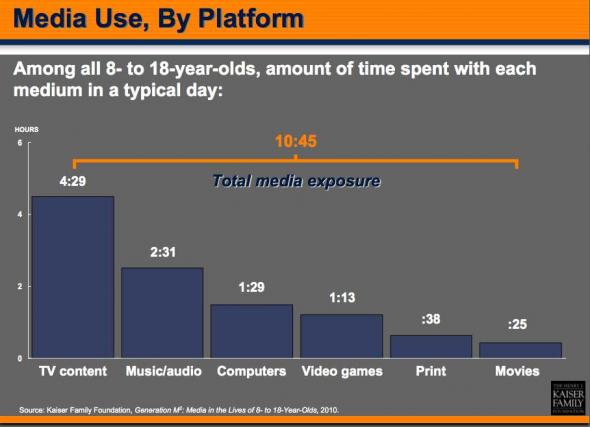Dylan Collins highlighted this survey on Business Insider about the media habits of 8-18 year olds.
The survey states that linear broadcast television still rules in the average youngster’s media habits. I wonder how much of this is access and availability versus desire and intent.
In 2010, probably most 8-18 year olds have access to at least one television. A vast percentage (71%) will likely have a television in their room. The television will more than likely be ‘on’ but just as we adults are conversant with co-viewing (using a laptop or mobile phone while viewing television), it stands to reason that our kids are doing much the same. The slide on media multitasking illustrates to me that kids are doing other things while watching television.
There’s also a significant trend towards on-demand content whether that’s DVD, Time-shifted TV, online video or video on iPod or cellphone. So while the consumption of Live Tv has decreased, the consumption of produced television media has overall increased – just not through the television necessarily. And I believe this trend will accelerate. A later slide indicates that only in 4% of households is the television off every time there is no-one watching it. A whopping 45% claim the TV is on when no-one is watching.
The other thing I see as significant is that printed media shows a marked skew towards books and away from magazines and newspapers. I believe this is because books represent a much less ephemeral media segment whereas newspapers and magazines have been mostly cannibalised by the internet. For example, a car bomb in Holywood at midnight last night was reported on Twitter for a full hour before it hit the main news web sites, reported on radio and television soon after and it would be unlikely to hit many print news stands this morning.
This survey measured the habits of the young. I’d be interested in viewing the desires and intent of the young with regards to media consumption. Do they want more (and presumably better) TV? Would they be in favour of faster internet? Better coverage for mobile internet? How will their habits change over the next 5 years?

Did you see last week’s BBC Click?
It pointed out similarly that more and more people are using computers as well as tele’s, and using the social media to comment about the quality of the programs that they are watching. It’s pretty much the same now with the likes of twitter, when a match is on, there is often feedback from folk who are watching, and more recently as you stated, when the bomb attack took place, social media was on top of the story 1 hour before the News networks started to take notice.
How long will it be before twitter is potentially used as a source of news through information from joe public ???
Hell, I even found out who was gonna be the Christmas no.1 2 HOURS BEFORE it was announced on BBC Radio 1!!! and that site had the top 20 songs listed EXACTLY as was announced.
I’ve sat with work mates, and showed them the power of twitter, and it’s not something to be sniffed at. Major News Company should really start taking note, as it’s one heck of a resource as much as it is a communication tool.